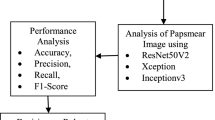Abstract
Cervical cancer is one of the main cause of cancer death, impacting 570,000 people globally. Cervical cancer is caused by the Human Papillomavirus (HPV), which causes abnormal cell growth in the cervical region. Periodic HPV testing in woman has helped to minimize the death rate in developed countries. However, due to a shortage of affordable medical facilities, developing countries are still striving to deliver low-cost solutions. The most commonly used screening test for early detection of abnormal cells and cancer is the Pap smear test. This paper explores existing deep learning model and recent research works done using publicly accessible Intel and Mobile-ODT Kaggle dataset for cervix detection and classification and ensures that these automated technologies helps pathologist in providing fast and cost-effective results.
Access this chapter
Tax calculation will be finalised at checkout
Purchases are for personal use only
Similar content being viewed by others
References
Alyafeai, Z. Ghouti, L.: A fully-automated deep learning pipeline for cervical cancer classification. Expert Syst. Appl. 141, 112951 (2020)
Gorantla, R., Singh, R.K., Pandey, R., Jain, M.: Cervical cancer diagnosis using CervixNet a deep learning approach. In: Proceedings of the 2019 IEEE 19th International Conference on Bioinformatics and Bioengineering, BIBE 2019, pp. 397–404 (2019). https://doi.org/10.1109/BIBE.2019.00078
Samperna, R., Boonstra, L., Van Rijthoven, M., Scholten, V., Tran, L.: Cervical cancer screening (Kaggle competition)
Zhang, X.Q., Zhao, S.G.: Cervical image classification based on image segmentation preprocessing and a CapsNet network model. Int. J. Imaging Syst. Technol. 29, 19–28 (2019)
Dhawan, S., Singh, K., Arora, M.: Cervix image classification for prognosis of cervical cancer using deep neural network with transfer learning. EAI Endorsed Trans. Pervasive Heal. Technol., 169183 (2018). https://doi.org/10.4108/eai.12-4-2021.169183
Payette, J., Rachleff, J. Van De Graaf, C.: Intel and MobileODT cervical cancer screening Kaggle competition: cervix type classification using deep learning and image classification. https://www.kaggle.com/c/
Aina, O.E., Adeshina, S.A., Aibinu, A.M.: Classification of cervix types using convolution neural network (CNN). In: 2019 15th International Conference on Electronics, Computer and Computation, ICECCO 2019, pp. 2019–2022 (2019). https://doi.org/10.1109/ICECCO48375.2019.9043206
Guo, P., Xue, Z., Rodney Long, L., Antani, S.: Cross-dataset evaluation of deep learning networks for uterine cervix segmentation. Diagnostics 10, 44 (2020)
Barros, H.: Deep learning for cervical cancer diagnosis: multimodal approach. https://www.mobileodt.com/products/evacolpo/
Guo, P., et al.: Ensemble deep learning for cervix image selection toward improving reliability in automated cervical precancer screening. Diagnostics 10, 451 (2020)
Pfohl, S., Triebe, O., Marafino, B.: Guiding the management of cervical cancer with convolutional neural networks
Hu, L., et al.: An observational study of deep learning and automated evaluation of cervical images for cancer screening. J. Natl. Cancer Inst. 111, 923–932 (2019)
Manna, A., Kundu, R., Kaplun, D., Sinitca, A., Sarkar, R.: A fuzzy rank-based ensemble of CNN models for classification of cervical cytology. Sci. Rep. 11, 1–18 (2021)
Author information
Authors and Affiliations
Corresponding authors
Editor information
Editors and Affiliations
Rights and permissions
Copyright information
© 2022 IFIP International Federation for Information Processing
About this paper
Cite this paper
Hemalatha, K., Vetriselvi, V. (2022). A Survey on Cervical Cancer Detection and Classification Using Deep Learning. In: Kalinathan, L., R., P., Kanmani, M., S., M. (eds) Computational Intelligence in Data Science. ICCIDS 2022. IFIP Advances in Information and Communication Technology, vol 654. Springer, Cham. https://doi.org/10.1007/978-3-031-16364-7_2
Download citation
DOI: https://doi.org/10.1007/978-3-031-16364-7_2
Published:
Publisher Name: Springer, Cham
Print ISBN: 978-3-031-16363-0
Online ISBN: 978-3-031-16364-7
eBook Packages: Computer ScienceComputer Science (R0)





